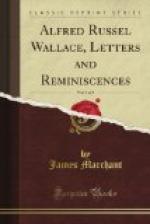I have been particularly struck with your remarks on dimorphism; but I cannot quite understand one point (p. 22), and should be grateful for an explanation, for I want fully to understand you.[54] How can one female form be selected and the intermediate forms die out, without also the other extreme form also dying out from not having the advantages of the first selected form? for, as I understand, both female forms occur on the same island. I quite agree with your distinction between dimorphic forms and varieties; but I doubt whether your criterion of dimorphic forms not producing intermediate offspring will suffice; for I know of a good many varieties, which must be so called, that will not blend or intermix, but produce offspring quite like either parent.
I have been particularly struck with your remarks on geological distribution in Celebes. It is impossible that anything could be better put, and [it] would give a cold shudder to the immutable naturalists.
And now I am going to ask a question which you will not like. How does your Journal get on? It will be a shame if you do not popularise your researches.
My health is so far improved that I am able to work one or two hours a day.—Believe me, dear Wallace, yours very sincerely,
CH. DARWIN.
* * * * *
9 St. Mark’s Crescent, Regent’s Park, N.W. February 4, 1866.
My dear Darwin,—I am very glad to hear you are a little better, and hope we shall soon have the pleasure of seeing your volume on “Variation under Domestication.” I do not see the difficulty you seem to feel about two or more female forms of one species. The most common or typical female form must have certain characters or qualities which are sufficiently advantageous to it to enable it to maintain its existence; in general, such as vary much from it die out. But occasionally a variation may occur which has special advantageous characters of its own (such as mimicking a protected species), and then this variation will maintain itself by selection. In no less than three of my polymorphic species of Papilio, one of the female forms mimics the Polydorus group, which, like the AEneas group in America, seems to have some special protection. In two or three other cases one of the female forms is confined to a restricted locality, to the conditions of which it is probably specially adapted. In other cases one of the female forms resembles the male, and perhaps receives a protection from the abundance of the males, in the crowd of which it is passed over. I think these considerations render the production of two or three forms of female very conceivable. The physiological difficulty is to me greater, of how each of two forms of female produces offspring like the other female as well as like itself, but no intermediates?
If you “know varieties that will not blend or intermix, but produce offspring quite like either parents,” is not that the very physiological test of a species which is wanting for the complete proof of the origin of species?




